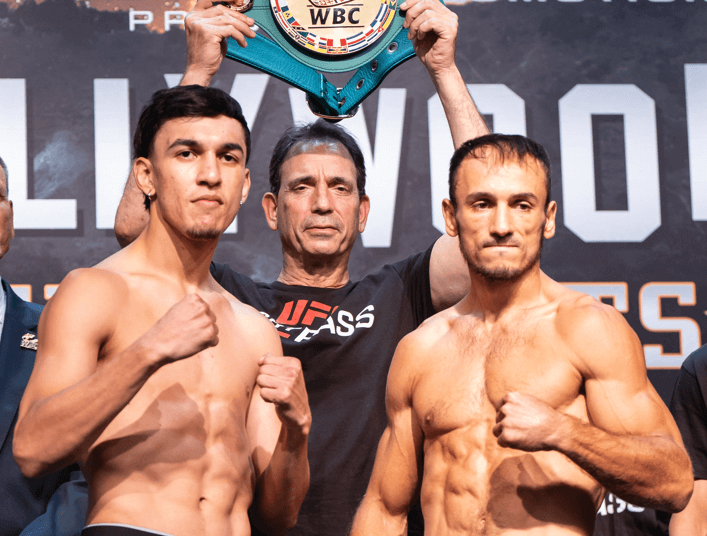Featured Articles
Fast-Rising Omar Trinidad KOs Slavinskyi at the Commerce Casino

East L.A.’s Omar Trinidad knocked out Ukraine’s Viktor Slavinskyi to retain the WBC Continental America’s featherweight title on Friday in a strategic but entertaining contest.
Fighting in front of frenzied crowd of supporters Trinidad (16-0-1, 13 KOs) defeated southpaw Slavinskyi (15-3-1, 7 KOs) with a measured and careful attack at the Commerce Casino in Commerce, Calif.
Fans familiar with Trinidad (pictured over the right shoulder of promoter Tom Loeffler) are familiar with his aggressive pressure fighting style, but the Boyle Heights pugilist took a careful approach against Slavinskyi. Instead of a pounding assault Trinidad kept the fight at a distance and used his reach advantage to perfection.
It was reminiscent of long-armed fighters of the past like the late great Mando Ramos of the late 1960s who could punch or box. Pick your poison.
Trinidad employed a constant jab and well-placed counter shots. The right hand, in particular, was especially effective.
“I couldn’t miss with the right,” said Trinidad
For seven rounds Trinidad dominated with counter-punching. Then, Slavinskyi increased the pressure and forced the East L.A. fighter to come along. He did.
“If I could get a knockout I’d put him in the blender,” Trinidad said.
From the eighth round until the end Trinidad engaged in his usual fast and furious style and was especially effective with uppercuts in ninth round. Slavinskyi walked into a right uppercut that sent him across the ring and into the ropes. Referee Ray Corona ruled it a knockdown.
In the final round Trinidad wasted no time in looking to unload with an uppercut and Slavinskyi walked into a right hand version. There was no escape as he was ruled unable to continue by Corona at 2:31 of the 10th and final round.
Trinidad keeps the title.
“The left hook and right uppercut was the money shot,” said Trinidad. “It was well-timed and it was a money shot.”
Welterweights
A fight between buddies from the same Armenian amateur team saw Aram Amirkhanyun (16-0-1, 4 KOs) defeat Gor Yeritsyan (18-1, 14 KOs) by split decision after 10 hard-fought rounds in a welterweight fight for a regional title.
The judges scored it 96-94 Yeritsyan and 96-94 twice for Amirkhanyun. No knockdowns were scored.
Iyana “Right Hook Roxy” Verduzco (2-0) proved that adapting into a pro style was not a problem in soundly defeating Pittsburgh’s Colleen Davis (3-2-1) after six featherweight rounds. Her best weapon was accuracy.
Verduzco, who is trained by her mother Gloria Alvarado, had been one of the most decorated amateur boxers for many years. In just her second pro fight the tell-tale signs of the amateur style were gone.
While the taller Davis circled rapidly to the left, Verduzco calmly waited for the openings and blasted away with pinpoint shots to the body and head. Her right hook was deadly accurate and the left found openings whenever they appeared.
Davis was able to land rights but just not enough to offset the incoming fire from the Southern California fighter. After six rounds all three judges scored it 60-54 for Verduzco.
In a firefight, Abel Mejia (5-0, 4 KOs) barely survived a second round knockdown against Tijuana’s rugged Jose Correa (6-10, 4 KOs) and rallied to remain relevant in the super featherweight match. In the fourth and final round Mejia beat Correa to the punch with a left hook that knocked out the tough Mexican challenger at 55 seconds as referee Ray Corona stopped the fight.
A super featherweight fight saw Hawaii’s Jaybrio Pe Benito (5-0, 4 KOs) power past Texan Michael Land (1-5-1) for a knockout win at 1:30 of the second round. Benito was too powerful and busy for Land who tried but was unable to slow down the assault.
Photo credit: Lina Baker
Ro comment on this story in the Fight Forum CLICK HERE
-

 Featured Articles3 weeks ago
Featured Articles3 weeks agoThe Hauser Report: Zayas-Garcia, Pacquiao, Usyk, and the NYSAC
-

 Featured Articles2 weeks ago
Featured Articles2 weeks agoOscar Duarte and Regis Prograis Prevail on an Action-Packed Fight Card in Chicago
-

 Featured Articles1 week ago
Featured Articles1 week agoThe Hauser Report: Cinematic and Literary Notes
-

 Book Review4 days ago
Book Review4 days agoMark Kriegel’s New Book About Mike Tyson is a Must-Read
-

 Featured Articles4 weeks ago
Featured Articles4 weeks agoManny Pacquiao and Mario Barrios Fight to a Draw; Fundora stops Tim Tszyu
-

 Featured Articles4 weeks ago
Featured Articles4 weeks agoArne’s Almanac: Pacquiao-Barrios Redux
-

 Featured Articles3 weeks ago
Featured Articles3 weeks agoRemembering Dwight Muhammad Qawi (1953-2025) and his Triumphant Return to Prison
-

 Featured Articles4 weeks ago
Featured Articles4 weeks agoOleksandr Usyk Continues to Amaze; KOs Daniel Dubois in 5 One-Sided Rounds


















